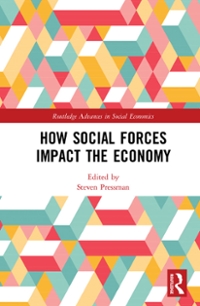Question
Suppose the federal funds rate target is 2%, the interest paid on excess reserves is 0.25% and the reserve requirement is 8%. The discount rate
Suppose the federal funds rate target is 2%, the interest paid on excess reserves is 0.25% and the reserve requirement is 8%. The discount rate is set according to current practice. 1. Illustrate the market for reserves, clearly labeling the market equilibrium (iff1* and R1*), relevant interest rates, and reserves (borrowed, BR1 and/or nonborrowed, NBR1). You must clearly label the axes, curves, equilibrium, and numerical values for the federal funds rate, the interest on reserves, and the discount rate. Label the equilibrium point A. [3]
2. Assume the total level of reserves in the banking system is equal to $7500. What portion of total reserves is held in nonborrowed reserves? What portion in borrowed reserves? Explain how you know, both in terms of your graph and intuitively. [3] 3. When the financial crisis began in 2007, there was a large increase in the banks' need for liquidity on their balance sheets. Does this affect reserve demand or reserve supply? Explain briefly why. [2] 4. Redraw your diagram from #1 here. Now, suppose the change in 3) resulted in a large change in borrowed reserves equal to $1000. Illustrate how this change affects the market for reserves, clearly labeling (where applicable) the new market equilibrium (iff2* and R2*), borrowed reserves (BR2) and nonborrowed reserves (NBR2). You must clearly label the new curve(s), and equilibrium values.
Assume the Federal Reserve does not respond to maintain the target. Label the equilibrium point B. [2] 5. State how each of the following variables change in your diagram (from Point A to Point B): federal funds rate, discount rate, total reserves, nonborrowed reserves, and borrowed reserves [2.5] 6. State how the following variables change when comparing points A and B: total reserves, borrowed reserves, nonborrowed reserves, the federal funds rate, the discount rate and the interest on reserves. [3] 7. Which organization within the Fed conducts open market operations? With whom do they conduct open market operations? Be specific. [2] 8. Assume the Fed uses open market operations to react to the situation described in 3)-6). With this involve a purchase or a sale? Are these operations dynamic or defensive? [2] 9. Show how this open market operation (mentioned in 8) will affect the balance sheets of (i) the Fed, (ii) nonbank public, and (iii) the banking system, assuming the operation involves $1200. T- account must balance. Clearly indicate an increase with a "+" and a decrease with a "-" symbol and state which entries on each T-account are changing (the name of the entry changing, and the numerical value of the change). [4] 10. Using your diagram from #4, illustrate how the open market operation described in 8-9) affects your reserves market diagram. Illustrate how this change affects the market for reserves, clearly labeling (where applicable) the new market equilibrium (iff3* and R3*), borrowed reserves (BR3) and nonborrowed reserves (NBR3). You must clearly label the new curve(s), and equilibrium values . Label the equilibrium point C. [3] 11. State how each of the following variables change in your diagram (from Point A to Point C): federal funds rate, discount rate, total reserves, nonborrowed reserves, and borrowed reserves [2.5] 12. Suppose that the financial crisis above lead to a 1% drop in the inflation rate and a 2% drop in the output gap. Using the Taylor rule, compute the implied change in the federal funds rate. Given the values at the beginning of the question, can the Federal Reserve achieve the federal funds rate implied by the Taylor rule? Be sure to show you work. [4] 13. Does the Federal Reserve have a dual mandate or a hierarchical mandate? Explain briefly and discuss the Fed's goals, citing the example above to support your answer.
Step by Step Solution
There are 3 Steps involved in it
Step: 1

Get Instant Access to Expert-Tailored Solutions
See step-by-step solutions with expert insights and AI powered tools for academic success
Step: 2

Step: 3

Ace Your Homework with AI
Get the answers you need in no time with our AI-driven, step-by-step assistance
Get Started


